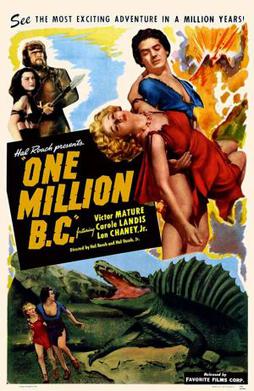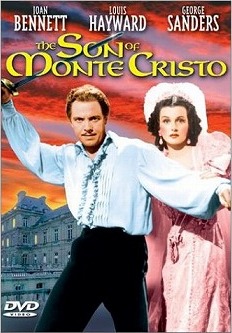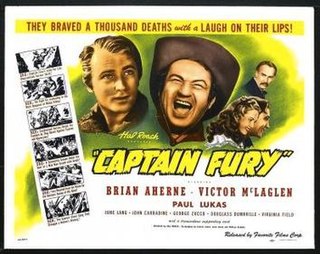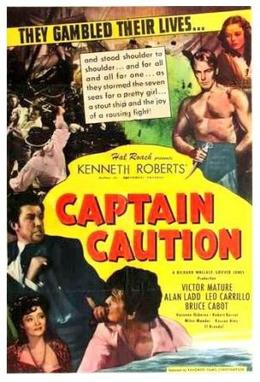Little Miss Marker is an American Pre-Code 1934 comedy-drama film directed by Alexander Hall. It was written by William R. Lipman, Sam Hellman, and Gladys Lehman after a 1932 short story of the same name by Damon Runyon. It stars Shirley Temple, Adolphe Menjou and Dorothy Dell in a story about a young girl held as collateral by gangsters. It was Temple's first starring role in a major motion picture and was crucial to establishing her as a major film star. It was inducted into the National Film Registry by the Library of Congress in 1998 and has been remade several times.

Harold Eugene "Hal" Roach Sr. was an American film and television producer, director, screenwriter, and centenarian, who was the founder of the namesake Hal Roach Studios.

Victor John Mature was an American stage, film, and television actor who was a leading man in Hollywood during the 1940s and 1950s. His best known film roles include One Million B.C. (1940), My Darling Clementine (1946), Kiss of Death (1947), Samson and Delilah (1949), and The Robe (1953). He also appeared in many musicals opposite such stars as Rita Hayworth and Betty Grable.

Joan Geraldine Bennett was an American stage, film, and television actress, one of three acting sisters from a show-business family. Beginning her career on the stage, Bennett appeared in more than 70 films from the era of silent films, well into the sound era. She is best remembered for her film noir femme fatale roles in director Fritz Lang's films—including Man Hunt (1941), The Woman in the Window (1944), and Scarlet Street (1945)—and for her television role as matriarch Elizabeth Collins Stoddard in the gothic 1960s soap opera Dark Shadows, for which she received an Emmy nomination in 1968.

George Raft was an American film actor and dancer identified with portrayals of gangsters in crime melodramas of the 1930s and 1940s. A stylish leading man in dozens of movies, Raft is remembered for his gangster roles in Quick Millions (1931) with Spencer Tracy, Scarface (1932) with Paul Muni, Each Dawn I Die (1939) with James Cagney, Invisible Stripes (1939) with Humphrey Bogart, and Billy Wilder's comedy Some Like It Hot (1959) with Marilyn Monroe and Jack Lemmon; and as a dancer in Bolero (1934) with Carole Lombard and a truck driver in They Drive by Night (1940) with Ann Sheridan, Ida Lupino and Bogart.

Topper is a 1937 American supernatural comedy film directed by Norman Z. McLeod, starring Constance Bennett and Cary Grant and featuring Roland Young. It tells the story of a stuffy, stuck-in-his-ways man who is haunted by the ghosts of a fun-loving married couple.

One Million B.C. is a 1940 American fantasy film produced by Hal Roach Studios and released by United Artists. It is also known by the titles Cave Man, Man and His Mate, and Tumak.

The Son of Monte Cristo is a 1940 American black-and-white swashbuckling adventure film from United Artists, produced by Edward Small, directed by Rowland V. Lee, that stars Louis Hayward, Joan Bennett, and George Sanders. The Small production uses the same sets and many of the same cast and production crew as his previous year's production of The Man in the Iron Mask. Hayward returned to star in Small's The Return of Monte Cristo (1946).

Convention City is a 1933 American pre-Code sex comedy film directed by Archie Mayo, and starring Joan Blondell, Guy Kibbee, Dick Powell, Mary Astor and Adolphe Menjou. The film was produced by Henry Blanke and First National Pictures and distributed by Warner Bros.

The House Across the Bay is a 1940 film directed by Archie Mayo, starring George Raft and Joan Bennett, produced by Walter Wanger, written by Myles Connolly and Kathryn Scola, and released by United Artists. The supporting cast features Lloyd Nolan, Walter Pidgeon and Gladys George.

George E. Stone was a Polish-born American character actor in films, radio, and television.

Captain Fury is a 1939 American Western film directed by Hal Roach. It is set in colonial Australia as one of Hollywood's few attempts to depict Australian history.

Something for the Birds is a 1952 American comedy film directed by Robert Wise and starring Victor Mature, Patricia Neal and Edmund Gwenn.
Keene Thompson was a story, scenario and screenwriter who worked in the film industry from 1920 to 1937.

Captain Caution is a 1940 American adventure film directed by Richard Wallace set during the War of 1812. The film stars Victor Mature, Bruce Cabot and Alan Ladd. It was based on the novel of the same name by Kenneth Roberts. Elmer Raguse was nominated for an Academy Award for Sound Recording.

The Ambassador's Daughter is a 1956 American romantic comedy film directed by Norman Krasna and starring Olivia de Havilland, John Forsythe and Myrna Loy. It was also produced and written by Krasna, and was distributed by United Artists. It was shot at the Joinville Studios in Paris. The film's sets were designed by the art director Léon Barsacq.

A Bill of Divorcement is a 1940 film directed by John Farrow. It was also known as Never to Love and was based on a 1921 British play of the same name, written by Clemence Dane that was filmed in 1932 with John Barrymore and Katharine Hepburn.

Syncopation is a 1942 American film from RKO directed by William Dieterle and starring Adolphe Menjou, Jackie Cooper, and Bonita Granville. It is set during the early days of jazz. It is also known as The Band Played On.

Fashions in Love is a 1929 American Pre-Code comedy film adapted by Melville Baker, Richard H. Digges Jr., and Louise Long from the play, "The Concert" by Hermann Bahr. It was directed by Victor Schertzinger and stars Adolphe Menjou, Fay Compton, Miriam Seegar, John Miljan, and Joan Standing. The film was released on June 29, 1929, by Paramount Pictures.

The Little Accident is a 1930 American pre-Code comedy film directed by William James Craft and written by Gladys Lehman and Gene Towne, based on the 1927 novel An Unmarried Father by Floyd Dell and the 1928 play Little Accident by Dell and Thomas Mitchell. The film stars Douglas Fairbanks, Jr., Anita Page, Sally Blane, ZaSu Pitts, Joan Marsh, and Roscoe Karns. The film was released on August 3, 1930, by Universal Pictures. It was remade by Universal in 1939 as Little Accident, and by RKO Radio Pictures in 1944 with Gary Cooper as Casanova Brown.


















